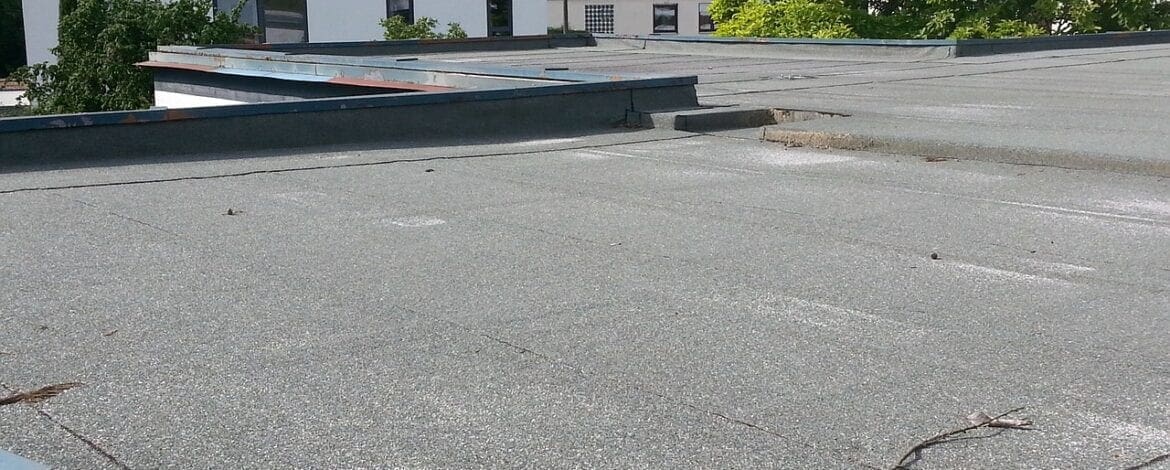Roll roofing is easy to install, economical, and practical for low-slope buildings. While it’s a quick and affordable solution, roll roofing isn’t a sheet anyone can install without considering a few factors. To help you figure out whether roll roofing is the best solution for you, we’ll highlight the most notable pros and cons and talk about the expected cost of your roll roofing project.
What is Roll Roofing?
Roll roofing, or MSR, is a mineral surfaced oil-based asphalt similar to asphalt shingles. Roll roofing is much cheaper than asphalt shingles but also thinner and less durable.
You can find it in almost any home improvement store, in a variety of different styles. And while roll roofing certainly isn’t winning any awards for its visual appearance, it gets the job done.
Roll roofing comes in three distinct types:
- Mineral finish roll roofing
- Smooth finish roofing sheets
- Saturated felt roofing
It’s important to note that roll roofing is rarely used for residences. Instead, it mostly finds application in utilitarian outbuildings such as sheds, garages, shops, barns. It’s also primarily used on roofs with a low slope.
The safest minimum roof pitch for rolled roofing is a 2:12 pitch. The maximum recommended roof pitch for which you can use roll roofing is a 1:12 pitch. Many people also use it on steeper roofs, but in such cases, a double layer of roll roofing is recommended.
How Much Does Roll Roofing Cost?
Understanding the cost of roof rolling is vital before undertaking such a significant household project. To make things easier, you can use this roll roof calculator. It will help you get an approximate cost for your new roll roof based on your location and the rolling you want to install.
Aside from getting the base cost from a calculator like this, it would be best to be careful when choosing your roofing contractor, as prices can vary significantly from business to business. Get at least a couple of estimates and make sure the roofing contractor is licensed and insured.
In most cases, these estimates usually come without an extra cost, like the free roof estimate we offer to all of our new customers.
Roll Roofing Pros
There are many reasons why roll roofing has been a prevalent roofing solution for decades. With that in mind, let’s take a closer look at the biggest pros of roll roofing:
- Affordable — Compared to even the least expensive shingle materials, roll roofing still comes out on top as the most affordable solution. Everything involved in the process, from the rolls and nails to the installation methods, is much cheaper than any other roofing option.
- Easy to Transport and Install — Roll roofing comes in tightly rolled up and sealed units, making them very light (about 75 pounds per unit) and easy to transport. Moreover, unlike other traditional roofing materials, which you have to lay down piece-by-piece, roll roofing goes down quickly. This means that it’s also a good choice for DIY roofers who don’t have much experience or machinery at their disposal.
- Adaptable — You can cut roll roofing into strips to act as hips and ridges, or even eaves and rakes, making this roofing solution very versatile. What’s more, if you want to install roll roofing on a roof with shingles, you can often simply re-roof over the existing surface. Before doing so, make sure to clean the surface from any debris that could damage the new roof from underneath.
Roll Roofing Cons
Of course, like any other roofing solution on the market, roll roofing also comes with its disadvantages. Here are the most prominent cons of roll roofing:
- Durability — Roll roofing is less durable than shingles. Since roll roofing is one uniform surface, it can’t properly adapt to any expanding or contracting as other traditional materials can. This means that any changes in the building’s structure will result in your roll roofing tearing.
- Short Lifespan — It’s worth mentioning that roll roofing has a short lifespan of five to eight years. This makes it more of a temporary roofing material than a long-term solution you can rely on for decades. Not only this, but roll roofing tends to develop bald spots after only a couple of years.
- No Curb Appeal — Roll roofing is also considered one of the least attractive roofing systems. If you’re looking to install a visually appealing roof, this isn’t the best choice. If you live in a gated community, the homeowner’s association may not allow its installation, even on an outbuilding.
- Low Resale Value — If you’re planning to sell your home soon, installing roll roofing on it or any outbuildings isn’t the best idea. Buildings with such a roof sell for significantly lower prices than households with tile, metal, and even asphalt roofs.
Considering Installing Roll Roofing? Contact Us Today
Rolled roofing is a convenient and affordable solution, but it certainly isn’t for every roof. If you’re considering installing roll roofing, and have any questions regarding it, contact us today. Our roofing experts will be happy to answer any queries you have concerning this topic.
Call 813-373-9088 or fill out our online form to get a free estimate for your next roofing project.



